Softly, as in a Morning Sunrise was composed by Sigmund Romberg and Oscar Hammerstein II in 1928 for an operetta (a kind of light opera) called The New Moon. Artie Shaw’s recording of Softly (1938) brought the song into the jazz world and made it into the popular jazz standard it is today.
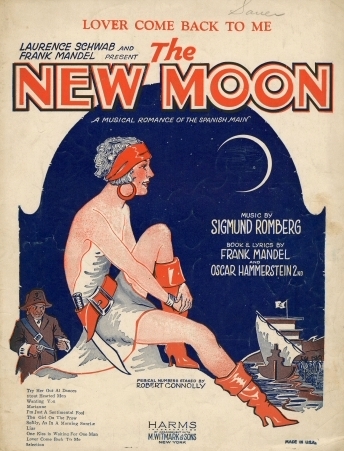
In this guitar lesson, you will learn how to play the melody and how to improvise over the chord changes of Softly.
Recommended listening:
- Emily Remler – East to Wes (1988)
- Jim Hall – Alone Together (1973)
- Chet Baker – Ballads for Two (1979)
- John Coltrane – Live! at the Village Vanguard (1962)
- Miles Davis – In Person Friday and Saturday Nights a the Blackhawk (2003)
- Stan Getz and Kenny Barron – People Time (2010)
- Sonny Rollins – A Night at the Village Vanguard (1958)
Video
Softly – The Melody
Here are the lead sheet and guitar tabs for Softly’s melody.
Most of the melody is in the C natural minor scale, besides a chromatic embellishment here and there. The natural minor scale is also known as the Aeolian mode, the sixth of the guitar modes.
Backing Track
Listen & Play Along
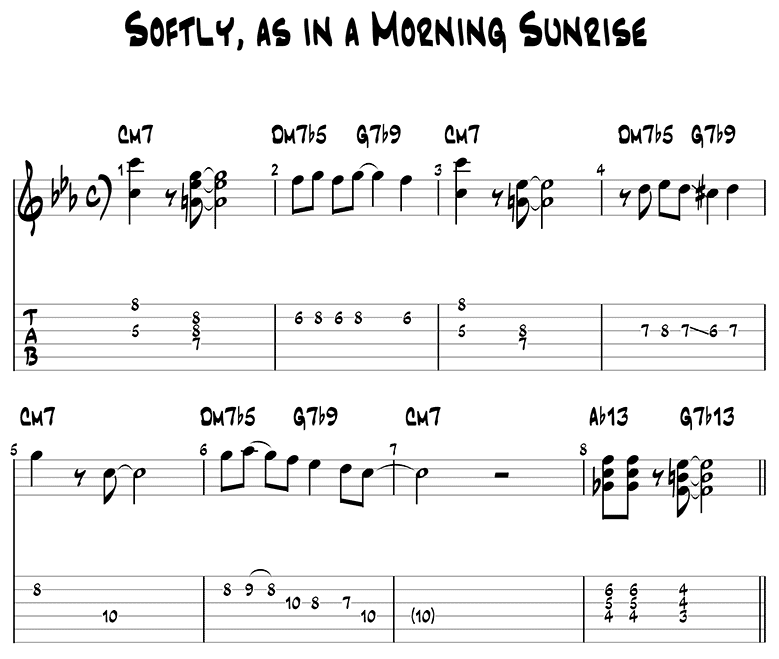
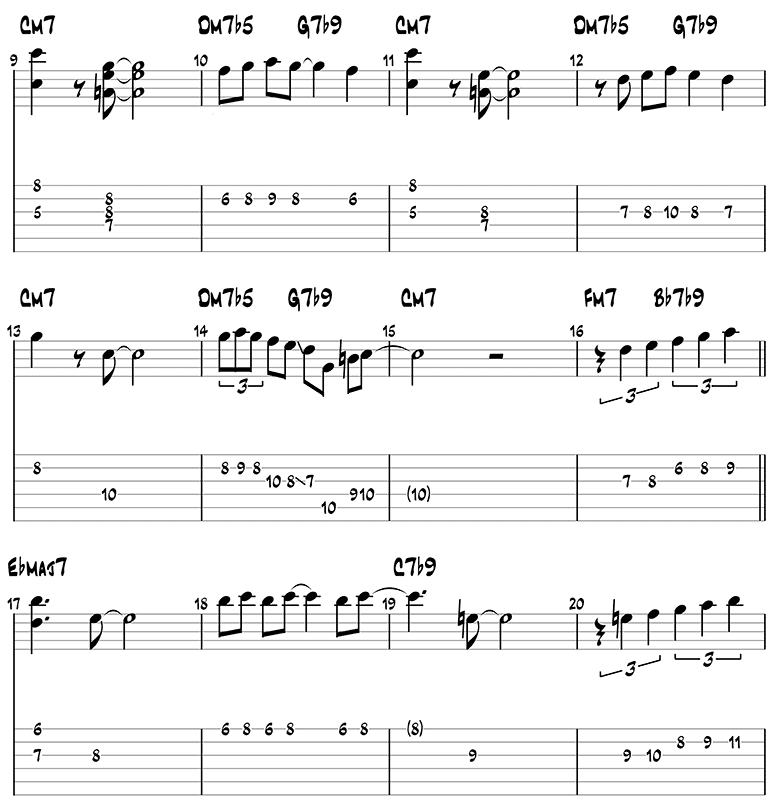
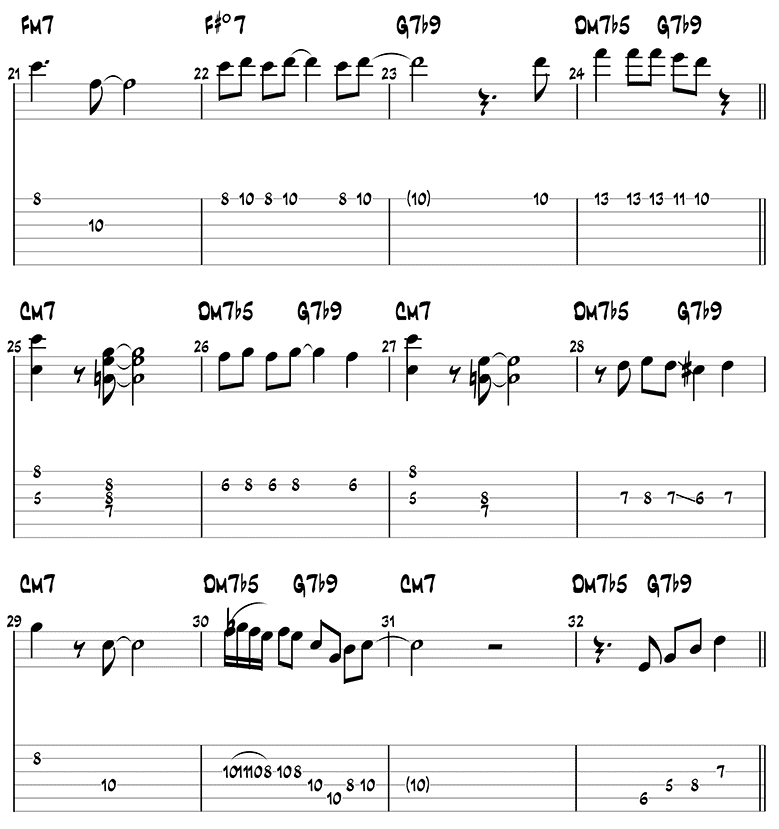
Jazz Guitar Patterns
Here are a couple of jazz patterns I lifted out of the solo and that are worth memorizing and working out in different keys and positions.
Pattern #1 (Bar 40) – Minor
The first pattern uses a G minor triad over Cm7.
| Gm triad | G | Bb | D |
|---|---|---|---|
| Played over Cm7 | 5 | b7 | 9 |

Pattern #2 (Bar 43) – Minor
Pattern 2 is based around a Bbmaj7 chord, including the classic 1235 pattern in bar 2.
| Bbmaj7 arpeggio | Bb | D | F | A |
|---|---|---|---|---|
| Played over Cm7 | b7 | 9 | 11 | 6 |
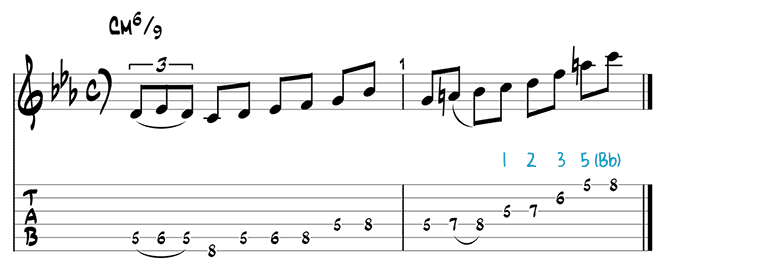
Pattern #3 (Bar 45) – Minor
Pattern 3 is a classic Wes Montgomery lick and uses the same substitution as the previous pattern, Bbmaj7 over Cm7.

Pattern #4 (Bar 46) – Minor
Pattern 4 is based around the chord shape of an Ebmaj7 chord, which is a common substitution over minor chords.
| Ebmaj7 arpeggio | Eb | G | Bb | D |
|---|---|---|---|---|
| Played over Cm7 | b3 | 5 | b7 | 9 |
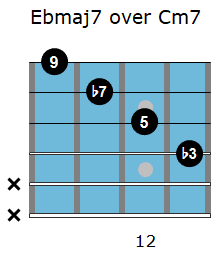

Pattern #5 (Bar 48) – Major II V I
Pattern 5 is a classic bebop lick that uses a 3 to b9 motif over the dominant chord.

Pattern #6 (Bar 56) – Dominant
Pattern 6 uses a Bdim7 arpeggio over G7, bringing out the b9 sound.
| Bdim7 arpeggio | B | D | F | Ab |
|---|---|---|---|---|
| Played over G7 | 3 | 5 | b7 | b9 |

Pattern #7 (Bar 58) – Minor
Pattern 7 uses two substitutions over Cm7 – Gm7 and Dm7.
| Gm7 arpeggio | G | Bb | D | F |
|---|---|---|---|---|
| Played over Cm7 | 5 | b7 | 9 | 11 |
| Dm7 arpeggio | D | F | A | C |
|---|---|---|---|---|
| Played over Cm7 | 9 | 11 | 6 | 1 |

Softly – The Solo
Here is the complete solo over Softly, as in a Morning Sunrise.
Softly is 32 bars long and has a classic AABA structure.
The harmony of the tune is fairly simple:
- The A parts are a repetition of minor II V I progressions in C.
- The B part starts on Ebmaj7, the relative major of C minor. It then goes to Fm7 via C7b9 and ends on G7b9, the dominant of Cm7.
Listen & Play Along
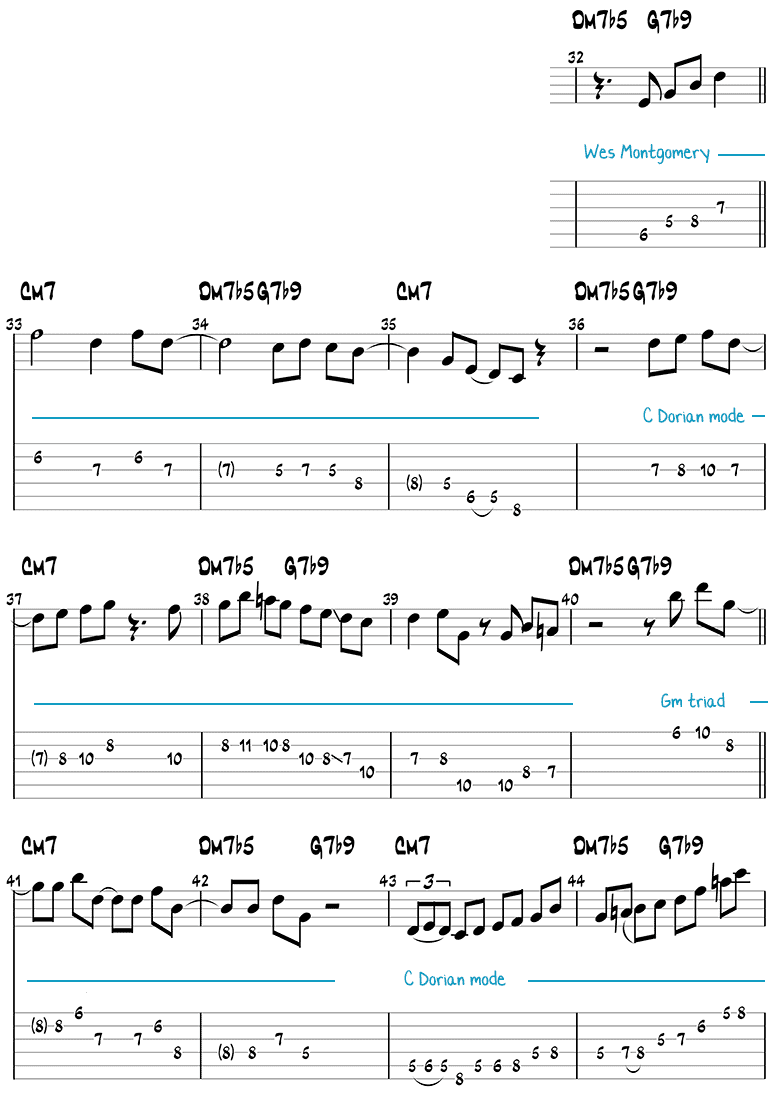
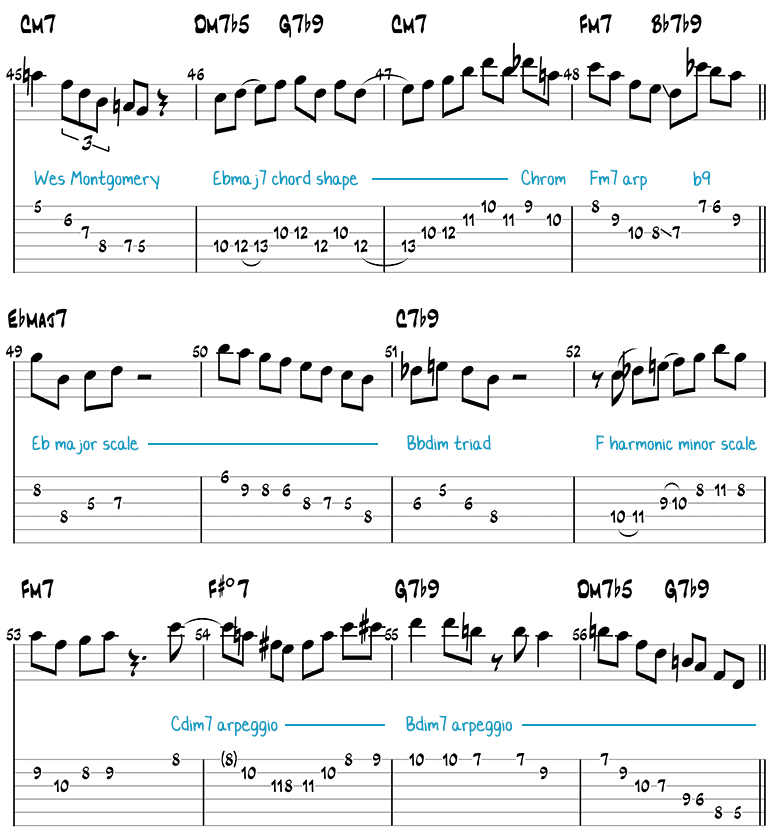
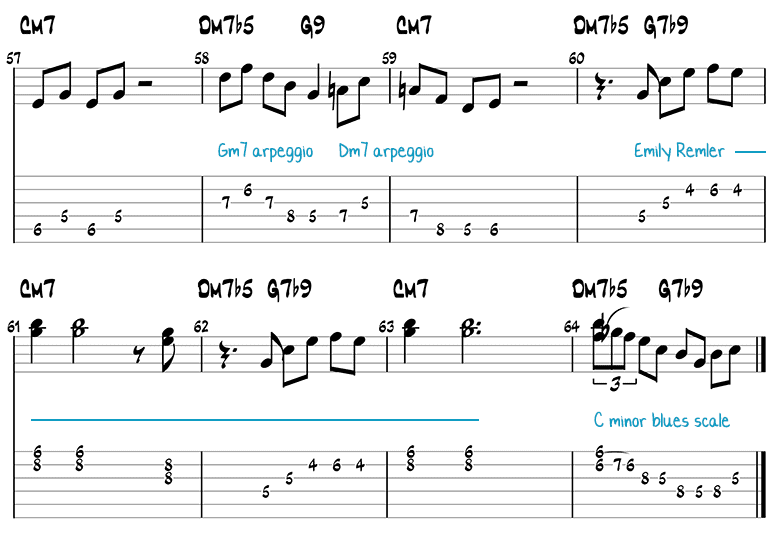
Softly, as in a Morning Sunrise Guitar Pro File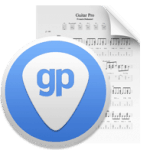



I’m a slightly experienced novice who just started getting back to my guitar for about 8 months. I hadn’t really played it for about 30 years due to travelling for work, etc. I had a pretty good ability to play chords and my instructor was honoring my initial desire to learn more chords and strumming patterns but over the last 2 months I extended my weekly lesson from 1/2 hour to a full hour. I really enjoy jazz and blues and I know all positions in the A minor pentatonic scales. I want to be able to solo for myself. When I practice I spend the first 20 minutes, sometimes longer on repeating the scale all along the fret board and I’m making good progress according to my instructor. I just turned 72 and playing guitar beats the heck out of doing word puzzles to maintain my sharpness and my focus. I spend another 20 minutes to 1/2 hour strumming and singing and then I spend as much time as I can playing using blues and jazz backtracking between 85 – 95 bpm. I’m fighting “GAS” – guitar acquisition syndrome, as I’ve purchased a Taylor Electric Acoustic, a Gretsch 2410 hollow body, and I recently purchased a PRS SE Standard. I play all of them in equal amounts of time every week. I use and love a Fender Mustang 25 amp for my electric guitars and an Acoustic A150 which I bought used for $50 in great condition for my acoustic electric. I’m a recent subscriber to Jazz Guitar but I don’t have the full subscription. My question is how can I get Jazz Guitar like I am now so that I can go to pieces in A minor. I love what I get regularly and may look into a full subscription soon but if you could answer my question I’d be very appreciative. I love what you send me. Thanks for any advice you are able to give me.
This is a great lesson, Thank you so much Dirk – you are a Star Sir!
excellent, thank you. Good timing, I was just starting to learn this one!
Grazie mille
Fantastic stuff you post for us! Thanks so much. I love this tune
Gran e instructivo trabajo. Muchas gracias maestro.
This is so out of my league but I think it’s fantastic how you post this.
Would you tell me which Fender amp you were using. I could not read the model. Sounded beautiful.
Thank you
Alan
Thanks Dirk for this lesson. It has some wonderful licks, but I would like to understand better the theory behind why some of these substitutions work, other than the fact, which you point out, that the subs touch extensions of the Cm7. For instance, while it is well known that the iii often subs for the I chord in a major key, and seems to work in the opposite direction when it is in a minor key (e.g. playing the Ebmaj7 over the Cm7 in this case), how can you explain why the Gm7 and Dm7 over the Cm7 works. Gm7 is not even diatonic to C minor. It is of course the iii of Eb major. Similarly, why does the Bbmaj7 chord substitute over the Cm7 as it is not diatonic to either the C minor or Eb major scales (it is a IV dominant 7 in Eb major and the VII dominant 7 of C minor)?
Ardy
Perhaps I can help a little with this Ardy.
2 chords that work well against each other do not have to strictly be in the same key, ie “diatonic”. As long as the notes in the overlaying arpeggio get the desired effect over the underlying chord, it works.
That effect could be to create tension (playing an Abmin6 over a G7 chord AND following that with a Gmin7 arp played over a Cmin7 chord to release that tension), or, just to add some cool tones over a minor chord.
In jazz, it sounds “hip” to play the 9th, the 6th/13th or the 4th/11th over a minor chord. Over a Cmin chord, the chords you mentioned (Bb major 7, Gm7 and Dm7) all add a mix of some of those extensions to the chord without also adding anything too glaring like a C# or E natural.
The Bb major and Gm7 also imply that the mode is C dorian. C dorian is based on the 2nd degree of the Bb major scale. It is basically a minor scale with a major 6th (A natural) and a flat 7th (Bb). It is a big part of the jazz minor sound as you probably know.
And, just to clarify something in your comment, a Bb Major 7th is not usually described as a dominant chord as it does not have both a major 3rd and flat 7th. : )
Hey Ardy, I hope this helps and good luck with your jazz guitar playing. Cheers
Hi Any.
-First a little theory. The basic chords of the song indicate the key of Cm in the context of functional tonal music, ie music that works the same way as a major key. None of the “diatonic” minor modes can function that way. To use them as real tonal music one had to cheat a bit and added extra notes, not strictly diatonic, such as the required leading tone B for Cm (giving the melodic and harmonic minor). This results in the practice that any of the chromatic notes between G up to C can be considered as a natural part of the Cm key in tonal music.
-One can consider the part of the song that repeats ii min7b5 – G7b9 – Cm as just a background to play freely any pattern or melody drawn from the key scale, including Gm7, Dm7 and Bbmaj7. They all will work.
-Another way of thinking is that it is just the Cm chord sounding all the time. The way Dirk starts explaining it suggests this approach. In that case the following applies.
-Gm7 played over Cm7 is simply the upper notes of Cm11. I prefer not to call it a substitution, but a chord extension. It is still a Cm chord!
Likewise Dm7 and Bbmaj7 are just a selection of notes from Cm11add6, another extended Cm chord.
Jazz soloists prefer to use the upper embellishments of the actual chord (extensions and alterations), especially avoiding the root. This can sometimes be a little confusing when transcribing or studying a solo if you want to find the underlying chord.
Have fun. Zee.
Sorry, Ardy that I spelled your name wrong :-). Zee
I find this very useful as a beginner
Excelente las Tab y se me facilita el poder entender el método de estudio 😎👍
Muy buena clase te agradezco muchísimas gracias!!!!
Wonderful!
Excelente la interpretación del tema y su improvisación.
Another fine arrangement!
Nice and smooth, liked it very much!
Thanks for spoiling us with all the songs you send.
Another really good tutorial! Absolute beginner but attempting to play this makes me feel good! Thank you
Merci !!! C’est vraiment génial
Thanks! I’ll work on it later!
Interesting facts:
Walk Don’t Run was composed by Johnny Smith using the chords of Softly. It sounded rather like Bach.
Chet Atkins recorded it in his own style.
The Ventures, who had never heard the original recording, changed the rhythm to an even quavers “scrubbing rhythm” and forced the melody over Amin G F E7 in the A section and altered the middle 8 a little. It was a big hit on the pop scene and was the first version I heard as a kid!